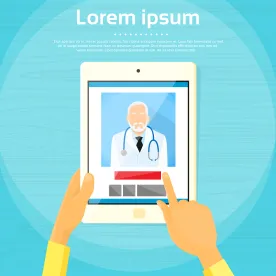China continues to advance policy supporting e-healthcare services and resources. On September 14, 2018, National Health Commission (“NHC”) and the National Administration of Traditional Chinese Medicine (“NATCM”) publicly released three new rules on internet based medical services and telemedicine. These rules cover the areas of e-diagnosis (“e-Diagnostic Rules”), internet-based hospitals (“e-Hospital Rules”) and telemedicine services (“Telemedicine Service Standard”) (collectively “e-Healthcare Rules”).[1]
Although the government issued a draft of these rules in 2017, the final e-Healthcare Rules appear to have been prompted by the Opinion on Improving the Development of “e-healthcare” Industry (“Opinion”) issued by China’s chief executive branch, the State Council on April 25, 2018. That Opinion requires enhancement and improvement of e-health services (including the application of artificial intelligence in the diagnostic process).
This blog entry focuses on key features of the e-Healthcare Rules.
Scope and Integration with Medical Device and Other Rules
The e-Healthcare Rules appear to permit commercial companies to collaborate with licensed medical institutions (e.g., hospitals and clinics) to provide e-diagnostic and telemedicine services or become e-hospitals. However, there is still no pathway for commercial companies to provide these services independently, unless they obtain a license to become a medical institution.
Although the e-Healthcare Rules outline the technical specifications for hardware and software required for e-hospitals and telemedicine services, they do not provide clear guidance on whether the hardware and software used would be need to be registered as medical devices with the National Medical Products Administration (“NMPA”), which has released guidelines on device software and mobile medical applications in the last three years.
e-Diagnostic Rules
The e-Diagnostic Rules govern the provision of diagnostic services to patients through the Internet. A medical institution must apply for approval to offer e-diagnostic services. However, a medical institution that provides these services does not need to be a registered e-hospital, which is a separate approval.
Only licensed doctors and nurses in China may provide e-diagnostic services. These personnel must be listed in the national healthcare professionals system and have at least 3-years of independent clinical practice experience. Participating physicians may not let e-diagnostic work jeopardize their primary responsibilities to provide inpatient services.
Patients may only use e-diagnostic clinical services for follow-up visits for certain common or chronic diseases. If there are any changes in symptoms that require an in-person evaluation, the physicians providing the e-diagnostic clinical services must refer the patient to traditional channels to continue treatment.
The e-diagnostic clinical services can be provided more freely when they are provided in conjunction within in-person visits (subject to the requirements applicable for telemedicine). In other words, if a patient is visiting a regular medical institution, other physicians are permitted to diagnose conditions remotely and prescribe medicine.
Controlled substances, including narcotic, psychotropic drugs and other drugs with a high risk of overdose may not be prescribed through e-diagnostic services. For children under six years old, there must be confirmation that the child is accompanied by his or her guardian or a professional physician when using the service.
e-Hospital Rules
The e-Hospital Rules set forth qualifications that a medical institution must have in order to become an accredited e-hospital. Medical institutions may apply to be solely e-hospitals or provide e-hospital services in addition to other traditional inpatient services (the latter circumstance is referred to as “e-hospitals under a second name”). Two points are worth noting about the intersection of e-hospitals and e-diagnostic services.
-
If a medical institution, either by itself or by collaboration with a third party, forms a platform to provide e-diagnostic clinical services using either its own or third party physicians, this medical institution must apply for “e-hospital under a second name.”
-
If a medical institution provides e-diagnostic clinical service only through its own registered physicians, then it may, but is not obligated to, apply for “e-hospital under a second name.”
In order to become an accredited e-hospital, a medical institutions must satisfy hardware and software requirements. These requirements include having no less than two sets of servers (the data server and the application server must be independent), uninterruptible power supply, high-speed internet connection, and a “data access system.” As with e-diagnostic services, the hospital must have appropriately licensed healthcare professionals on staff.
Telemedicine Service Standard
China has been actively promoting the development of telemedicine services through hospitals since 2014. The Telemedicine Service Standard regulates collaborations between hospitals in providing medical services via remote connection to patients.
Among other requirements, participants must enter into a collaboration agreements. The agreement must specify the scope and conditions of the collaboration, service procedures, the rights and obligations of the parties, and the allocation of medical malpractice risks.
When using a telemedicine service, patients must be informed of the scope of remote healthcare service, and the cost, and sign an informed consent form to this effect.
Third Party Collaborations
Collaborations with a third party (including commercial entities) to provide e-diagnostic clinical service or form e-hospitals require a written collaboration agreement reviewed by the local healthcare regulator. In addition to setting forth rights and obligations, the collaboration agreement must address data privacy issues. If an e-hospital collaboration changes (e.g., new partners), the agreement must be resubmitted for review and the e-hospital will require de novo approval. There is no simple amendment procedure.
Other Key Points
-
Retroactive Effect. Both the e-Diagnostic Rules and the e-Hospital Rules require that any medical institution providing e-diagnostic services prior to the effective date of these rules must apply for the relevant permission (either the e-diagnostic clinical service approval or the recognition as an e-hospital) within 30 days.
-
Introduction of Technology. The e-Healthcare Rules also encourage the introduction of advanced technology in the provision of clinical services, including facial recognition software for physicians.
-
Liability Insurance. The e-Healthcare Rules require either the e-hospital or a participant in the collaboration to purchase the liability insurance for the physicians. The e-Healthcare Rules do not set forth thresholds for this liability insurance or other requirements.
* * *
Companies and organizations in the e-healthcare service industry should closely monitor future developments related to the implementation of the e-Healthcare Rules in order to make necessary adjustments to their business strategies in China.
[1] The names of the rules released are (i) Measures on the Management of Internet Diagnostic (“e-Diagnostic Rules”); (ii) Measures on the Management of Internet Hospital (“e-Hospital Rules”); and (iii) Administrative Standards for Telemedicine Service (“Telemedicine Service Standard.” The notice releasing the e-Healthcare Rules is dated July 17, 2018, but it was not released publicly until September 14, 2018.





 />i
/>i

